ASUS PQ321Q UltraHD Monitor Review: Living with a 31.5-inch 4K Desktop Display
by Chris Heinonen on July 23, 2013 9:01 AM ESTUniformity is tested by using 25 locations across the screen and measuring the color checker chart at each of them. From there we can pull out contrast, black and white uniformity, and color uniformity. This review is the first to utilize the newest measurement available in CalMAN 5.1.2: dE From Center. Now instead of measuring the dE2000 at every location, we measure it relative to the center measurement.
This gives us a true uniformity measure. I could measure the left side and the right side of the monitor and get a dE2000 of 2.0 for each side. What that doesn’t tell me is that the left side might be red tinted, and the right side blue tinted, while the center might be green tinted. In this case they could all measure the same dE2000, but look totally different. By comparing the measured values to the center, we get an actual measurement of if one area of the screen will look the same as another area. Since we always use the center of the screen as our calibration target, which is why everything is measured relative to that.
Starting out with White Uniformity, we see decent but not amazing results. The panel stays within +/- 10% for the center, but falls down to a 17% variation at the edges. The light fall-off is relatively high, and makes me wonder if the look of the panel, and its thin design, might place a bit of emphasis on style over substance.
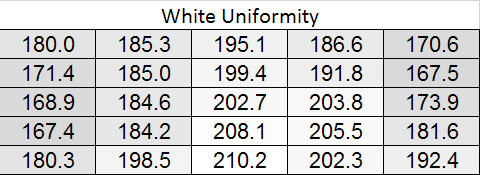

With the black level charts we see similar results. The middle of the panel is +/- 10% again, but the edges fall off to a nearly 20% difference. There is a curious rise in black level in one measure where there was a fall-off in white level, but otherwise the results between the two measurements are similar.
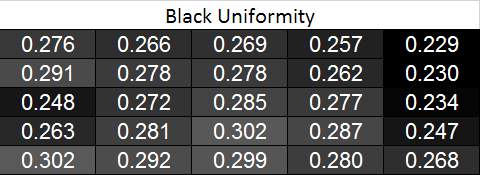
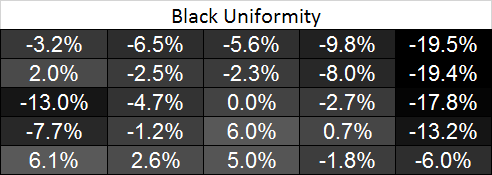
Looking at the resulting contrast, the numbers here are much closer to 100%, which we expect to see. Areas with light fall-off affect the white and black levels almost equally, so the contrast ratios are very similar all across the screen. That gives us a 700:1 expected contrast ratio for the screen as a whole.
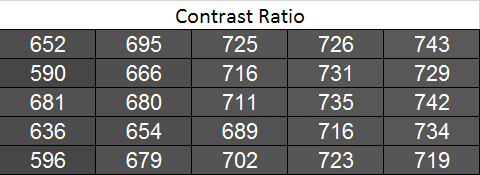
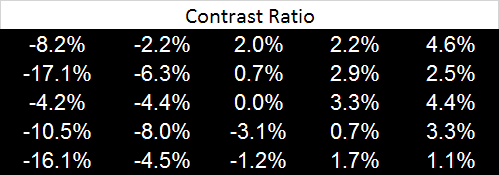
Now we can see the new dE2000 From Center data. The issues here crop up at the outsides of the screen, where we see the backlighting issues earlier. Uneven lighting is the issue most likely to cause color issues on the screen, and that is certainly backed up here. In the center of the screen, you are going to not see a difference in colors when you look directly at the screen. With a light loss of less than 10%, and a color dE2000 of <2 for most of the center screen, everything will look identical. As you get to the extreme edges you will run into more issues. I will need more monitors to be tested with this new method, but I think this is going to wind up as a good result in the end.

Going with an LED lighting system, and not a backlit array one, is always a bit of a concern for me. Overall the PQ321Q does well for uniformity for using one, and it avoids some of the massive issues we have seen with some LED systems before. But we are looking for near-perfection from the ASUS and it can’t quite do that. The center 60% of the screen is excellent overall, and for most people that will mean you may not notice these issues at all, but they are there.










166 Comments
View All Comments
Mondozai - Tuesday, July 23, 2013 - link
BUT BUT BUT, we were told everything above 720p was overkill and stupid!Where are Anandtechs resident armchair experts now?!
Despoiler - Tuesday, July 23, 2013 - link
It depends on how close you are to the display and the size of the display. 4k will definitely help in a computing environment. It will do no good in common TV viewing scenarios. 4k will however sell TVs because you typically buy TVs at the store where you are up close to it. http://carltonbale.com/does-4k-resolution-matter/beginner99 - Tuesday, July 23, 2013 - link
Exactly. Most people either have a too small tv or sit too far away to even benefit from ful HD or even 720p.kevith - Tuesday, July 23, 2013 - link
Well, doesn´t that depend on what you mean by "benefit"? (I know the eyes have an upper limit, when it comes to resolution, giving a max distance from your TV/monitor)I have never experienced a High DPI screen - like a Retina - in real life, but I know a great deal about the difference when it comes to sound.
What is it excactly, that makes a 2000 dollar stereo set better than a 500 dollar one? It´s very hard to put your finger on one parameter and say.: "It´s that!" or "It´s this!" "Better transients" or "better bass" are just subjective expressions.
At the end of the day, it very often comes down to: "It simply sounds "softer" to my ears". Or: "You can turn the volume up way higher, before it starts to sound harsh or rough".
I don´t know, I just presume it´s the same with screens: The higher the res, the "softer" the picture wil feel to your eyes. Even if we actually exceed the resolution capabilities of the eye.
Despoiler - Tuesday, July 23, 2013 - link
It's that your eyes physically cannot resolve the difference in resolution at a certain distance combined with a certain size of screen. ie 720, 1080, or 4k look the same if you are sitting far enough back.Integr8d - Wednesday, July 24, 2013 - link
720p is rougly the maximum visual acuity for a moving image. For static images, the more resolution the better. For movies or gaming (save for the occasional sniper shot, where most of the screen is still) 720p is most your brain can process.shaurz - Wednesday, July 24, 2013 - link
That sounds like bollocks to me. I can easily tell the difference between a game running at 720p and 1080p.doobydoo - Thursday, July 25, 2013 - link
He said 'if you are sitting far enough back'. Can you tell the difference between a game running at 720p and 1080p from 1 mile away? No.Ortanon - Wednesday, July 24, 2013 - link
...at a certain viewing angle [distance].Shadowself - Wednesday, July 24, 2013 - link
Absolutely not. Please read my earlier post.Additionally, motion actually enhances a lot of the acuity requirements. You can actually see motion (especially if it's repetitive) that is on the order of one arc minute or less.